#dad1df Color Information
In a RGB color space, hex #dad1df is composed of 85.5% red, 82% green and 87.5% blue. Whereas in a CMYK color space, it is composed of 2.2% cyan, 6.3% magenta, 0% yellow and 12.5% black. It has a hue angle of 278.6 degrees, a saturation of 17.9% and a lightness of 84.7%. #dad1df color hex could be obtained by blending #ffffff with #b5a3bf. Closest websafe color is: #cccccc.
-
- R 85
- G 82
- B 87
-
- C 2
- M 6
- Y 0
- K 13
● #dad1df color description : Light grayish violet.
#dad1df Color Conversion
The hexadecimal color #dad1df has RGB values of R:218, G:209, B:223 and CMYK values of C:0.02, M:0.06, Y:0, K:0.13. Its decimal value is 14340575.
| Hex triplet | dad1df | #dad1df |
|---|---|---|
| RGB Decimal | 218, 209, 223 | rgb(218,209,223) |
| RGB Percent | 85.5, 82, 87.5 | rgb(85.5%,82%,87.5%) |
| CMYK | 2, 6, 0, 13 | |
| HSL | 278.6°, 17.9, 84.7 | hsl(278.6,17.9%,84.7%) |
| HSV (or HSB) | 278.6°, 6.3, 87.5 | |
| Web Safe | cccccc | #cccccc |
| CIE-LAB | 84.912, 5.621, -5.797 |
|---|---|
| XYZ | 65.031, 65.834, 79.089 |
| xyY | 0.31, 0.314, 65.834 |
| CIE-LCH | 84.912, 8.075, 314.115 |
| CIE-LUV | 84.912, 4.234, -9.891 |
| Hunter-Lab | 81.138, 1.072, -0.996 |
| Binary | 11011010, 11010001, 11011111 |
Color Schemes with #dad1df
Alternatives to #dad1df
Below, you can see some colors close to #dad1df. Having a set of related colors can be useful if you need an inspirational alternative to your original color choice.
#dad1df Preview
This text has a font color of #dad1df.
<span style="color:#dad1df;">Text here</span>This paragraph has a background color of #dad1df.
<p style="background-color:#dad1df;">Content here</p>This element has a border color of #dad1df.
<div style="border:1px solid #dad1df;">Content here</div>.text {color:#dad1df;}.background {background-color:#dad1df;}.border {border:1px solid #dad1df;}Shades and Tints of #dad1df
A shade is achieved by adding black to any pure hue, while a tint is created by mixing white to any pure color. In this example, #000000 is the darkest color, while #f6f4f7 is the lightest one.
-
#000000
#000000rgb(0,0,0) -
#0b080c
#0b080crgb(11,8,12) -
#151017
#151017rgb(21,16,23) -
#1f1823
#1f1823rgb(31,24,35) -
#29202f
#29202frgb(41,32,47) -
#34283a
#34283argb(52,40,58) -
#3e3046
#3e3046rgb(62,48,70) -
#483951
#483951rgb(72,57,81) -
#53415d
#53415drgb(83,65,93) -
#5d4968
#5d4968rgb(93,73,104) -
#675174
#675174rgb(103,81,116) -
#725980
#725980rgb(114,89,128) -
#7c618b
#7c618brgb(124,97,139)
-
#866997
#866997rgb(134,105,151) -
#90749f
#90749frgb(144,116,159) -
#9980a7
#9980a7rgb(153,128,167) -
#a28caf
#a28cafrgb(162,140,175) -
#ab97b7
#ab97b7rgb(171,151,183) -
#b5a3bf
#b5a3bfrgb(181,163,191) -
#beaec7
#beaec7rgb(190,174,199) -
#c7bacf
#c7bacfrgb(199,186,207) -
#d1c5d7
#d1c5d7rgb(209,197,215) -
#dad1df
#dad1dfrgb(218,209,223) -
#e3dde7
#e3dde7rgb(227,221,231) -
#ede8ef
#ede8efrgb(237,232,239) -
#f6f4f7
#f6f4f7rgb(246,244,247)
Tones of #dad1df
A tone is produced by adding gray to any pure hue. In this case, #d8d7d9 is the less saturated color, while #e3b3fd is the most saturated one.
-
#d8d7d9
#d8d7d9rgb(216,215,217) -
#d9d4dc
#d9d4dcrgb(217,212,220) -
#dad1df
#dad1dfrgb(218,209,223) -
#dbcee2
#dbcee2rgb(219,206,226) -
#dccbe5
#dccbe5rgb(220,203,229) -
#ddc8e8
#ddc8e8rgb(221,200,232) -
#ddc5eb
#ddc5ebrgb(221,197,235) -
#dec2ee
#dec2eergb(222,194,238) -
#dfbff1
#dfbff1rgb(223,191,241) -
#e0bcf4
#e0bcf4rgb(224,188,244) -
#e1b9f7
#e1b9f7rgb(225,185,247) -
#e2b6fa
#e2b6fargb(226,182,250) -
#e3b3fd
#e3b3fdrgb(227,179,253)
Color Blindness Simulator
Below, you can see how #dad1df is perceived by people affected by a color vision deficiency. This can be useful if you need to ensure your color combinations are accessible to color-blind users.
